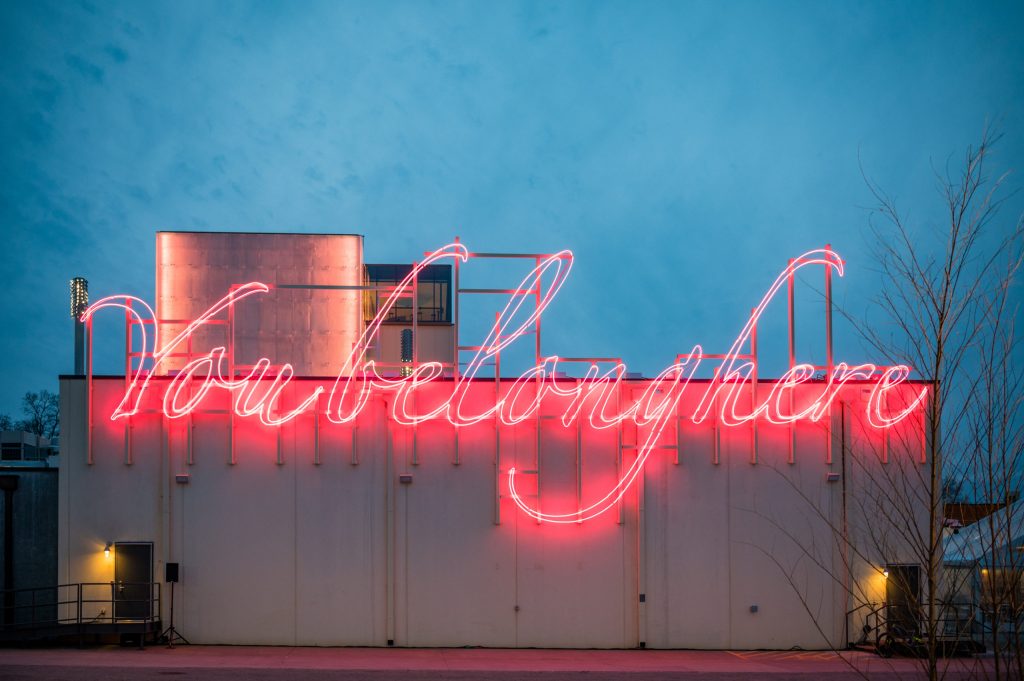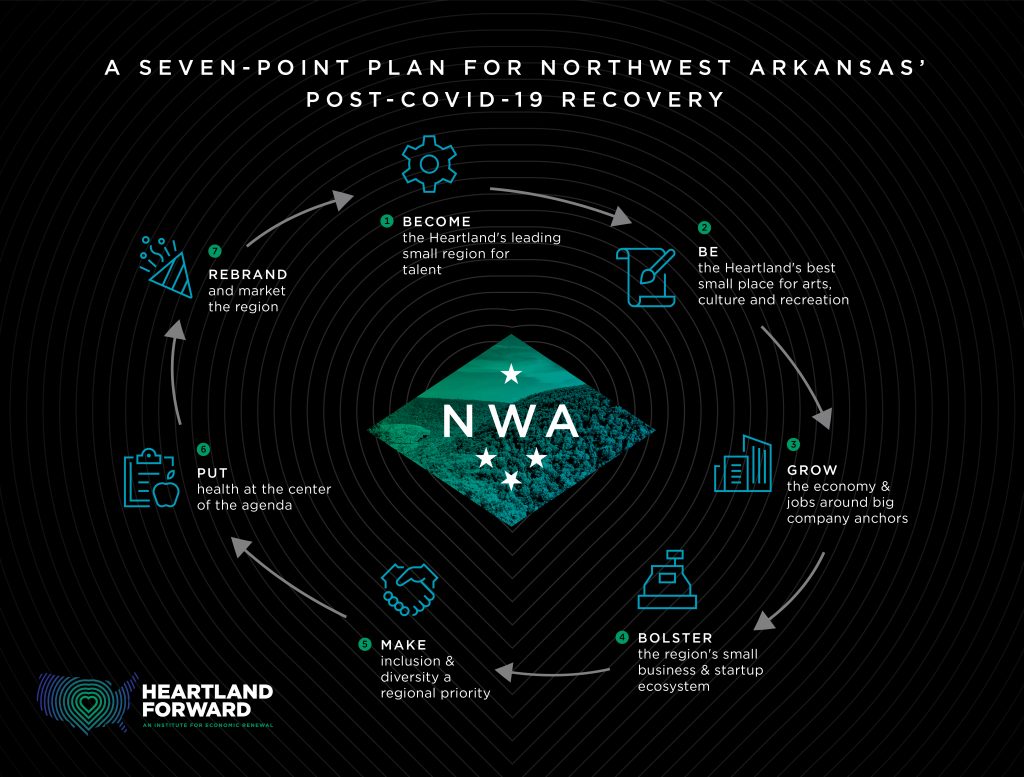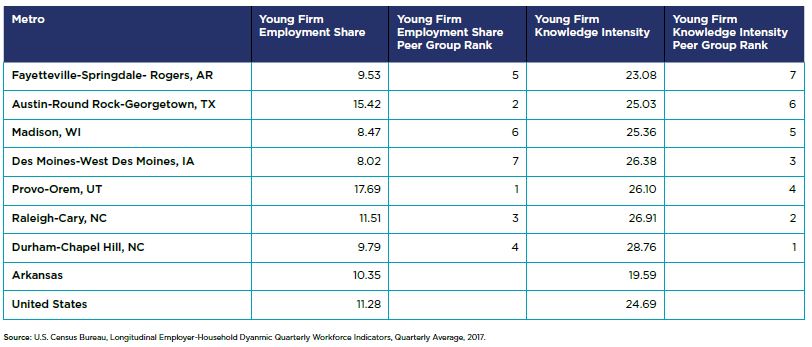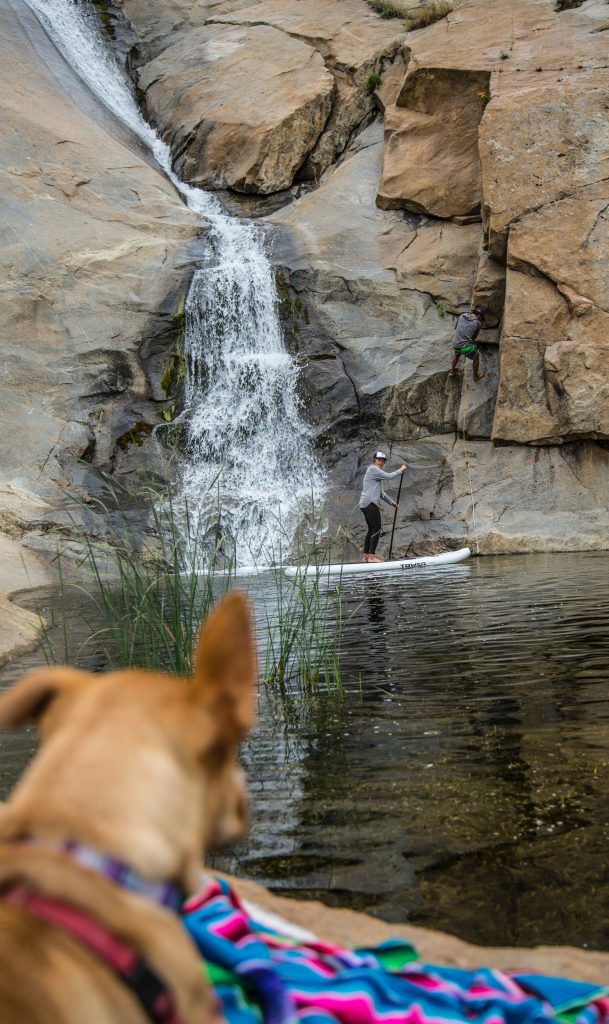EXECUTIVE SUMMARY
COVID-19 presents great challenges to Northwest Arkansas (NWA) as it does to every community, but the region is in strong standing to weather this global pandemic.
Ensuring it does so requires leveraging – and enhancing – the region’s economic, social and demographic strengths while addressing its weaknesses.
To generate such an economic recovery strategy, Heartland Forward (HF) has undertaken an extensive and detailed analysis of the NWA region’s strengths, challenges and opportunities. Our team has arrayed and assessed comprehensive data on its economy and industries, its small businesses and startup ecosystem, talent base, changing demographic composition and quality of place that stems from its arts, culture and recreation efforts and initiatives to develop a robust strategy for post-COVID-19 recovery.
We supplemented these details with interviews and focus groups with real people living in NWA and representing each of these core sectors and communities to provide in-depth background into what is happening on the ground in NWA.
Before the crisis hit, our assessment indicates that the region was performing well . . . excelling in population growth, job and wage growth and other vital metrics.
NWA ranked:
• fourth in population growth of the more than 100 U.S. metro areas with more than 500,000 people since 1990,
• third in job growth, and
• second in annual average pay gains among medium-size metropolitan areas (i.e., populations of 500,000 to 999,999) between 2013 and 2018.

2010-2019 Population Growth in U.S. Metropolitan Areas
(For mobile viewers, we recommend landscape orientation.)
NWA is in a good place for the post-COVID-19 environment, but the region cannot afford to be complacent. A comprehensive and intentional post-COVID-19 recovery strategy can build off key strategies and investments put in place over the past decade to strengthen the region’s economy. Specifically, the region should leverage its knowledge and university base; arts and culture offerings; outdoor recreation, biking infrastructure and quality of place; and a national airport, among other things to build an even more vibrant, inclusive, healthier and more resilient economy for the future.
Based on our research and interviews, we have identified seven key elements that underpin the region’s post-COVID-19 recovery strategy, and the report contains specific actions around them.

1. Become the Heartland’s Leading Region for Talent
The region has made great strides in attracting talent. We believe its combination of well-known, successful corporate anchors, flagship land-grant research university, affordability and livability enable it to do much more. Superstar cities and tech hubs on the coasts have been attracting people who fuel the innovation economy. But, the combination of the COVID-19 crisis, which has generally impacted lower density areas less than key urban concentrations, and the long-term affordability challenges that have emerged in both the northeast and west coast, have contributed to the rising appeal of smaller regions across the Heartland. This is especially true of families who are looking for more affordable communities that offer both abundant economic opportunity and lifestyle amenities. NWA is among the leading U.S. metro areas to take advantage of these shifts.
RECOMMENDATIONS:
To build upon recent success, NWA should become the Heartland’s leading small region for talent. It should offer families and remote workers the best place to live. It should also create a talent moonshot initiative, investing resources to attract the 100 best and brightest techies, scientists, entrepreneurs and creatives to the region. It should focus on recruiting and retaining thousands of retail vendors who currently make the region a part-time home. The NWA area must work harder to build a greater critical mass of young professionals, singles and those without family, and create a Campus NWA initiative to retain students who come to its universities and colleges.

2. Be the Heartland’s Best Place for Arts, Culture and Recreation
NWA made defining investments in institutions like the Crystal Bridges Museum of American Art, The Momentary, Walton Arts Center, Arkansas Music Pavilion (AMP), the Scott Family Amazeum and Museum of Native American History, among others. It has a thriving restaurant and music scene and an excellent network of bike trails – 400+ miles of hard and soft surfaces, lakes and open spaces. The region’s arts, cultural and recreational offerings are comparable to that of a major city or metro area. With strategic investment, NWA is primed to offer creative talent a great place to live and do work in a more affordable, healthier environment.
In the same category of arts and culture, further investment in an already-thriving culinary arts scene will be important. For example, NWA could link to the local agricultural and protein ecosystem. A number of initial investments have already been made with a new age of award-winning chefs on the scene working alongside local restaurateurs.
RECOMMENDATIONS:
NWA must double down on its already significant investments in arts and culture, which are essential for attracting and retaining talent and building the future economy. Also, the region should build platforms that support and enhance the opportunities for local and regionally sourced culture. This should be spread across the region, showcasing the diverse backgrounds of each of the communities that make up Northwest Arkansas. For instance, how do you increase the number of residents living in Springdale who enjoy the music by the House of Songs in Bentonville? Or, are Rogers residents aware of the unique cuisine in Springdale that they might have enjoyed and loved when living in a big city? Arts and culture are what make this community unique, already having top rated facilities in the city’s backyard has created a buzz globally but simple communication and thinking about different ways NWA residents can access these incredible assets both in person and virtually will continue to drive retainment for residents to stay in the area, along with economic development.

3. Grow the Economy and Jobs Around Big Company Anchors
The COVID-19 crisis has caused near-record unemployment. More and more, Americans are looking not just for great places to live, but areas that offer stable, long-term jobs. The region has incredible, large company anchors for a metro of its size, with three major Fortune 500 companies — Walmart, Tyson Foods and J.B. Hunt, which provide stable employment and shape a robust labor market. The region should build-up its already world-class clusters in corporate management and logistics, which are significant growth industries for the future. Supply chain management is also an area of research focus for the University of Arkansas. These primary industries have proven their critical worth in the pandemic and make the area a natural place for new innovations.
RECOMMENDATIONS:
NWA should create the world’s leading cluster and industrial commons in supply, delivery and logistics, combining the strengths and skills of
its large firms, talent base, and university research while supporting the growth of dynamic small firms and startups in this field. NWA could also create an online tool/platform that would allow current and future residents to easily access jobs and opportunities in the region and across various business sectors. Additional coordination among the large corporations (e.g., Walmart, Tyson Foods, J.B. Hunt) in the area could be beneficial for residents to effectively search for jobs, professional contacts and networking opportunities in the area. This could also be helpful for the many professionals and families that transfer to the region with a trailing spouse or partner.

4. Bolster the Region’s Small Business and Startup Ecosystems
In today’s economy, thriving entrepreneurial ecosystems are a key feature of economic success. Despite strengths elsewhere, NWA ranks in the “middle of the pack” of all metros and last out of seven peer regions on its performance on young dynamic firms, according to Heartland Forward research. Cities with a higher share of employment at young firms, and particularly where employees at those young firms have a bachelor’s degree or higher, saw notably faster employment growth over the past decade.

The current governor of the state, Asa Hutchinson, has established an organization called the Governor’s Innovation Council since taking office. Its purpose is to help scale Arkansas ventures through three key focuses: acceleration, capital and talent. This organization has been
able to gather an advisory board of CEOs of the largest private and nonprofit organizations of the state. Much like Innovate Arkansas, there are a multitude of other opportunities for entrepreneurial growth with accelerators like Grit Studios and Plug and Play NWA among others. Also, many other efforts include Start-up Junkie, the Brewer Family Entrepreneurship Hub for Entrepreneurship at the University of Arkansas and UA Start-up Village.
RECOMMENDATIONS:
Bolstering and developing its dynamic young firms and its startup ecosystem must be a key priority for the region. To do so, the region should develop accessible small business loans focused on underserved segments, establish and activate a formalized angel investor network, engage firms in research and technology transfer partnerships at the University of Arkansas and promote startup weekends and other programs for technology and entrepreneurial talent.

5. Make Inclusion and Diversity a Regional Priority
The COVID-19 crisis and a wave of political protests have focused America’s attention on long-standing divides of race and class, with both the health and economic fallout from it hitting hardest on the Black and Hispanic communities. The region is home to a historic Black community, but also now is home to a large, rapidly growing Hispanic population and a smaller but rapidly growing Marshallese community. Surprising to many, the Marshallese population in NWA is the largest in the U.S.
RECOMMENDATIONS:
Diversity, equity and inclusion (DEI) must be at the center of the region’s economic development agenda moving forward. It must be a business priority and centerpiece of the region’s impressive arts, culture and recreation initiatives, which should be tailored and expanded to meet the needs of less advantaged and minority populations and communities. Greater coordination among businesses, non-profit organizations and local leaders should be the first step in addressing this issue. While great work is being done by many, strong coordination must be addressed for the region to truly accelerate and deliver on the types of things that are accepted by evolving the NWA community.

6. Put Health and Resilience at the Center of the Agenda
The COVID-19 crisis has put a premium on health and safety. People across the country and the world are looking for regions that will proactively address the crisis and enable them to remain healthy. NWA has dealt relatively effectively with the pandemic with rates of infection and fatality significantly lower than other metro areas. The region needs to build off this success and put health and safety front and center on its economic and social agenda.
RECOMMENDATIONS:
the creation of a new academic medical center provides an opportunity to be a world leader in health and resiliency. The vision for the region should be to lead across the full spectrum of healthcare, from self-care to primary care to specialty care, in a “whole health” paradigm. A
top-tier academic medical center, in collaboration with a nationally recognized health system,
provides the opportunity to train medical practitioners and recruit healthcare leaders.

7. Rebrand and Market the Region
Last but not least, the region deserves a new brand. NWA was established to unify the communities around a common, collaborative brand but doesn’t convey the region’s vibrancy today. This has been a key point of our focus groups and conversations, and the NWA Council has found a similar sentiment in its surveys. Communities like Austin and Nashville receive huge brand advantages from their names. Another option is to find a unique and clever moniker like the Research Triangle. We must keep in perspective that branding should emphasize conveying what qualities of the region are most appealing to talent, entrepreneurs and firms that might move here.
The region must develop a more powerful new brand, especially to communicate its message and success to national and global audiences. Some consultants might suggest taking advantage of a rhyme with communities with “ville” in their name. The region is a corridor from the north to the south. Bentonville has real momentum and buzz under it, as a place that is really on the move. And, Fayetteville is a college town that is similar in some ways to Boulder or Ann Arbor. However, this risks underappreciating the important roles that Rogers and Springdale play in the broader region. The rebranding could focus on the distinct qualities of the region, such as corporations, colleges and culture. Stakeholders in the region must make this determination while not discounting input offered from its northern-to southern-most point.Additional data used in the generation of this strategy can be found by clicking this button

